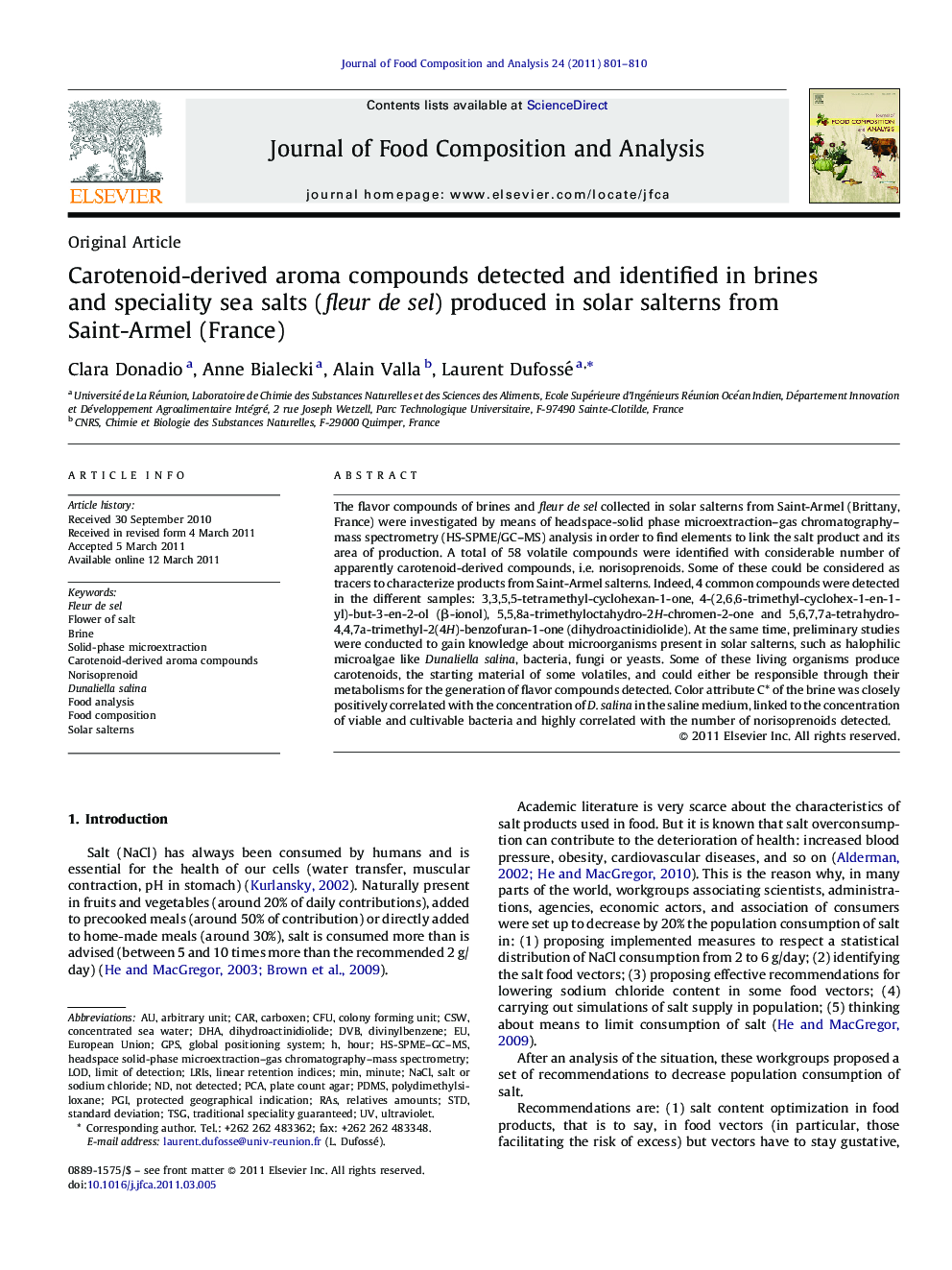| کد مقاله | کد نشریه | سال انتشار | مقاله انگلیسی | نسخه تمام متن |
|---|---|---|---|---|
| 10552850 | 967614 | 2011 | 10 صفحه PDF | دانلود رایگان |
عنوان انگلیسی مقاله ISI
Carotenoid-derived aroma compounds detected and identified in brines and speciality sea salts (fleur de sel) produced in solar salterns from Saint-Armel (France)
دانلود مقاله + سفارش ترجمه
دانلود مقاله ISI انگلیسی
رایگان برای ایرانیان
کلمات کلیدی
CarboxenRASHS-SPME–GC–MSSTDTSGNaClDunaliella salinaDVBPDMSCSWPGICFUPCA - PCAbrine - آبنمکEuropean Union - اتحادیه اروپاUltraviolet - اشعه فرابنفشstandard deviation - انحراف معیارsolid-phase microextraction - بیوفیزیک جامد فازFood analysis - تجزیه و تحلیل مواد غذاییFood composition - ترکیب مواد غذاییnot detected - تشخیص داده نشدMin - حداقلsolar salterns - خورشیدminute - دقیقهDHA - دوکوساهگزائنوئیک اسیدdivinylbenzene - دیوینیل بنزنHour - ساعتGPS - سامانه موقعیتیاب جهانیGlobal Positioning System - سیستم موقعیت یاب جهانیlinear retention indices - شاخص های نگهداری خطیPlate Count Agar - شمارش آگارLod - لودCAR - ماشینlimit of detection - محدودیت تشخیصProtected geographical indication - نشانه جغرافیایی حفاظت شدهArbitrary Unit - واحد خودآموزPolydimethylsiloxane - پلیمتیلسیلوکسانcolony forming unit - کلنی واحد تشکیل
موضوعات مرتبط
مهندسی و علوم پایه
شیمی
شیمی آنالیزی یا شیمی تجزیه
پیش نمایش صفحه اول مقاله

چکیده انگلیسی
The flavor compounds of brines and fleur de sel collected in solar salterns from Saint-Armel (Brittany, France) were investigated by means of headspace-solid phase microextraction-gas chromatography-mass spectrometry (HS-SPME/GC-MS) analysis in order to find elements to link the salt product and its area of production. A total of 58 volatile compounds were identified with considerable number of apparently carotenoid-derived compounds, i.e. norisoprenoids. Some of these could be considered as tracers to characterize products from Saint-Armel salterns. Indeed, 4 common compounds were detected in the different samples: 3,3,5,5-tetramethyl-cyclohexan-1-one, 4-(2,6,6-trimethyl-cyclohex-1-en-1-yl)-but-3-en-2-ol (β-ionol), 5,5,8a-trimethyloctahydro-2H-chromen-2-one and 5,6,7,7a-tetrahydro-4,4,7a-trimethyl-2(4H)-benzofuran-1-one (dihydroactinidiolide). At the same time, preliminary studies were conducted to gain knowledge about microorganisms present in solar salterns, such as halophilic microalgae like Dunaliella salina, bacteria, fungi or yeasts. Some of these living organisms produce carotenoids, the starting material of some volatiles, and could either be responsible through their metabolisms for the generation of flavor compounds detected. Color attribute C* of the brine was closely positively correlated with the concentration of D. salina in the saline medium, linked to the concentration of viable and cultivable bacteria and highly correlated with the number of norisoprenoids detected.
ناشر
Database: Elsevier - ScienceDirect (ساینس دایرکت)
Journal: Journal of Food Composition and Analysis - Volume 24, Issue 6, September 2011, Pages 801-810
Journal: Journal of Food Composition and Analysis - Volume 24, Issue 6, September 2011, Pages 801-810
نویسندگان
Clara Donadio, Anne Bialecki, Alain Valla, Laurent Dufossé,